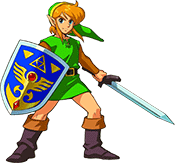Link to the Past
Release Dates
Super Nintendo
US : April 13, 1992
Japan : November 21, 1991
Europe : September 24, 1992
Game Boy Advance
US : December 2, 2002
Japan : March 14, 2003
Europe : March 28, 2003
Virtual Console
US : January 22, 2007
Japan : December 2, 2006
Europe : March 23, 2007
Australia : March 23, 2007
Developer
Publisher : Nintendo
Developer : Nintendo
Director : Takashi Tezuka
Producer : Shigeru Miyamoto
Game
Genre : Action, Adventure
Platform : Super Nintendo Entertainment System
Other Platforms : Wii (Virtual Console), Game Boy Advance, 3DS (Virtual Console)
Game Type : 8 megabit cartridge
Mode : Single Player
Memory : 41 blocks + 4 save (Wii)
Wii Points : 800 Points
Ratings
ESRB : E (Everyone)
OFLC : G
Reviews
Metacritic : 95%
After what seemed an eternity, Link finally made his way onto the Super NES in 1991. In a “prequel” to the first two adventures, Link is called on to save the land of Hyrule from Ganondorf’s forces, which have found the secret entrance to the Golden Land and are wreaking havoc. With the help of the wizard Agahnim, Ganondorf has kidnapped Princess Zelda and stolen back into the World of Darkness.
After collecting three special talismans from the World of Light, Link can move back and forth between the worlds of Light and Darkness to recover the eight pieces of the Triforce. After he retrieves them, a final showdown takes place in the Dark Pyramid. There, Link must fight and defeat both Agahnim and Ganon himself!
 A Link to the Past was the first Zelda game that truly did the land of Hyrule justice. The game is incredibly large, featuring two overworlds that need exploring as well as 11 dungeons that Link must fight his way through. A Link to the Past was also the best game in the Zelda series until Ocarina of Time was released and is considered a classic by everyone who has ever played it.
A Link to the Past was the first Zelda game that truly did the land of Hyrule justice. The game is incredibly large, featuring two overworlds that need exploring as well as 11 dungeons that Link must fight his way through. A Link to the Past was also the best game in the Zelda series until Ocarina of Time was released and is considered a classic by everyone who has ever played it.
First off, the graphics in A Link to the Past are very good. Only later Super NES games such as Donkey Kong Country had graphics that were much better than the graphics in A Link to the Past. The fact that the game was released on the Super Nintendo console allowed enemies to be much larger than ever before. Bosses at least ten times the size of Link were routine in this game, allowing for some epic boss battles at the end of every dungeon.
The music in A Link to the Past was great. Each song set the mood perfectly for where Link was or what he was doing. The sound quality was as good as or better than that of any other Super NES game, and out of the entire Zelda series, only Ocarina of Time had better music.
The dungeons in the game were very well put together. Like the other Zelda games, hidden inside each dungeon is a special item that Link must find and use in order to get through the dungeon. At the end of each dungeon is a challenging boss creature that guards either a pendant or a crystal. Just like the bosses in each of the other Zelda games, in A Link to the Past each boss requires a different strategy in order to be defeated. Aside from the bosses, there were many other dangers inside each dungeon. There were all kinds of monsters just waiting to ambush Link and many of the dungeons contained puzzles that Link must solve in order to move on.
A Link to the Past also introduced many innovative features that are present in the games that were released after it. Instead of collecting an entire Heart Container at a time (with the exception of at the end of a dungeon), Link would have to find four Pieces of Heart in order to gain a Heart Container. The game also introduced several new items, some of which have appeared in it's sequels. One of these items is the Hookshot, a long chain that hooks onto an object and pulls Link towards it. Another feature that originated in A Link to the Past was the need of a Boss Key (called the Big Key in this game) in order to move on to the guardian of a particular dungeon. These new features all helped make A Link to the Past the game that changed the Zelda series from a popular series to the most popular games Nintendo has to offer.

